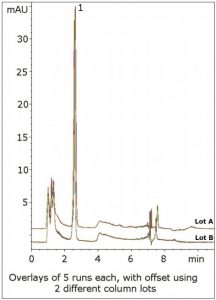Unique Retention Mode Affords Superior Specificity
Although Caffeine retains well in Reversed Phase, it is found to be difficult to obtain a well-resolved Peak free of interference from other matrix peaks with a complex sample such as coffee. In this Method, most of the matrix peaks elute near the void volume and do not interfere with the Caffeine Peak, which is well-resolved from the others.
Complex matrices can also adversely affect run-to-run repeatability due to compounds that do not elute from the Column and change the chromatography. Here the data shows no sign of contaminant build-up on the Column, as the run-to-run overlays show. The lot-to-lot reproducibility is good as well. Finally, the Method conditions are LCMS compatible.

 Peak:
Peak:
Caffeine
Method Conditions
Column: Cogent Diamond Hydride™, 4µm, 100Å
Catalog No.: 70000-7.5P
Dimensions: 4.6 x 75mm
Mobile Phase:
—A: DI Water / 0.1% Formic Acid (v/v)
—B: Acetonitrile / 0.1% Formic Acid (v/v)
Gradient:
| Time (minutes) | %B |
| 0 | 98 |
| 2 | 98 |
| 7 | 50 |
| 8 | 98 |
Post Time: 3 minutes
Injection vol.: 1µL
Flow rate: 1.0mL / minute
Detection: UV @ 275nm
Sample Preparation: Commercially available ground coffee was brewed and filtered with a 0.45µm Nylon Syringe Filter (MicroSolv Tech Corp.). It was then diluted 1:10 with a diluent of 50:50 Solvent A / Solvent B. The Caffeine Peak identity was confirmed with a USP reference standard.
t0: 0.9 minutes
Note: Caffeine is a Xanthine Alkaloid found in the coffee plant, the tea bush, the kola nut, and other plants. It is the most commonly consumed psychoactive drug in the world.
Attachment
No 223 Caffeine in Coffee Analyzed with HPLC pdf 0.4 Mb Download File


